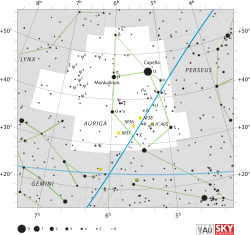Upsilon Aurigae

| |
| Observation data Epoch J2000 Equinox J2000 | |
|---|---|
| Constellation | Auriga |
| Right ascension | 05h 51m 02.43724s[1] |
| Declination | +37° 18′ 20.0565″[1] |
| Apparent magnitude (V) | 4.74[2] |
| Characteristics | |
| Spectral type | M0 III[3] |
| U−B color index | +1.93[2] |
| B−V color index | +1.62[2] |
| R−I color index | 1.07 |
| Astrometry | |
| Radial velocity (Rv) | +37.68[4] km/s |
| Proper motion (μ) | RA: +36.85[1] mas/yr Dec.: -45.52[1] mas/yr |
| Parallax (π) | 6.24 ± 0.65[1] mas |
| Distance | approx. 520 ly (approx. 160 pc) |
| Details | |
| Radius | 73[5] R☉ |
| Other designations | |
Upsilon Aurigae (υ Aur, υ Aurigae) is the Bayer designation for a star in the northern constellation of Auriga. It has an apparent visual magnitude of 4.74,[2] which means it is bright enough to be seen with the naked eye. Based upon parallax measurements made during the Hipparcos mission, this star is approximately 520 light-years (160 parsecs) distant from the Earth.
This is an evolved red giant star with a stellar classification of M0 III.[3] It is a suspected variable star[7] and is currently on the asymptotic giant branch, which means it is generating energy at its core through the fusion of helium.[8] The measured angular diameter of this star, after correction for limb darkening, is 4.24 ± 0.05 mas.[9] At the estimated distance of Upsilon Aurigae,[1] this yields a physical size of about 73 times the radius of the Sun.[5]
References
- 1 2 3 4 5 6 van Leeuwen, Floor (November 2007), "Validation of the new Hipparcos reduction", Astronomy and Astrophysics, 474 (2): 653–664, arXiv:0708.1752v1
 , Bibcode:2007A&A...474..653V, doi:10.1051/0004-6361:20078357. Note: see VizieR catalogue I/311.
, Bibcode:2007A&A...474..653V, doi:10.1051/0004-6361:20078357. Note: see VizieR catalogue I/311. - 1 2 3 4 Johnson, H. L.; et al. (1966), "UBVRIJKL photometry of the bright stars", Communications of the Lunar and Planetary Laboratory, 4 (99): 99, Bibcode:1966CoLPL...4...99J
- 1 2 Keenan, Philip C.; Barnbaum, Cecilia (June 1999), "Revision and Calibration of MK Luminosity Classes for Cool Giants by HIPPARCOS Parallaxes", The Astrophysical Journal, 518 (2): 859–865, Bibcode:1999ApJ...518..859K, doi:10.1086/307311.
- ↑ Famaey, B.; et al. (January 2005), "Local kinematics of K and M giants from CORAVEL/Hipparcos/Tycho-2 data. Revisiting the concept of superclusters", Astronomy and Astrophysics, 430 (1): 165–186, arXiv:astro-ph/0409579
 , Bibcode:2005A&A...430..165F, doi:10.1051/0004-6361:20041272.
, Bibcode:2005A&A...430..165F, doi:10.1051/0004-6361:20041272. - 1 2 Lang, Kenneth R. (2006), Astrophysical formulae, Astronomy and astrophysics library, 1 (3rd ed.), Birkhäuser, ISBN 3-540-29692-1. The radius (R*) is given by:
- ↑ "ups Aur -- Variable Star", SIMBAD Astronomical Database, Centre de Données astronomiques de Strasbourg, retrieved 2012-08-23.
- ↑ Hamada, K.; et al. (January 1979), "On the Variability of upsilon Aurigae", Information Bulletin on Variable Stars, 1531: 1, Bibcode:1979IBVS.1531....1H.
- ↑ Eggen, Olin J. (July 1992), "Asymptotic giant branch stars near the sun", Astronomical Journal, 104 (1): 275–313, Bibcode:1992AJ....104..275E, doi:10.1086/116239.
- ↑ Richichi, A.; Percheron, I.; Khristoforova, M. (February 2005), "CHARM2: An updated Catalog of High Angular Resolution Measurements", Astronomy and Astrophysics, 431 (2): 773–777, Bibcode:2005A&A...431..773R, doi:10.1051/0004-6361:20042039.